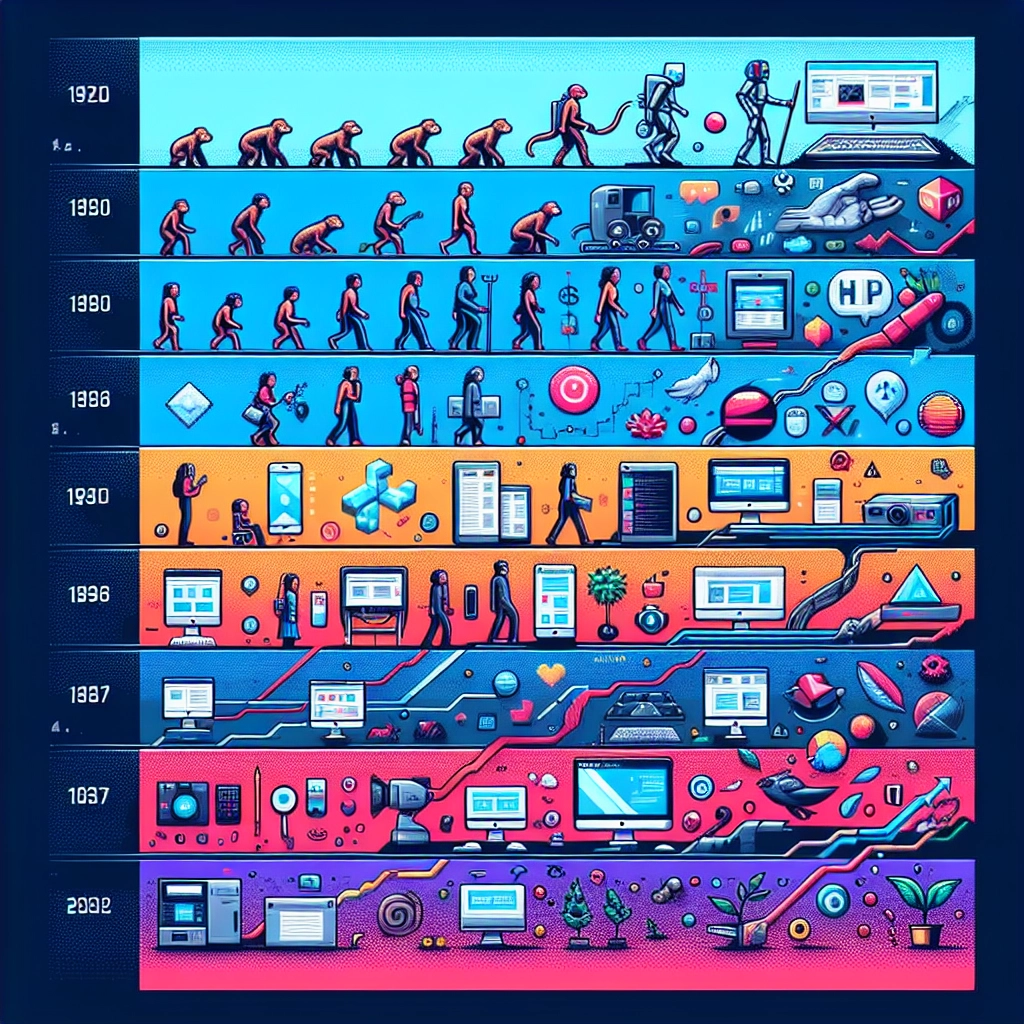Web design has undergone significant transformations, evolving from pixelated table layouts and basic sketches to sophisticated AI-generated experiences. As artificial intelligence reshapes creativity, it is not replacing designers but rather positioning them as directors of a smarter web.
Web design has long operated at the intersection of creativity and technology, adapting not only to technical innovations but also to cultural shifts and changing user expectations. As we enter the AI era, this transformation is accelerating.
The Static Years: HTML Tables and Pixel Perfection
In the early 90s, web design resembled typesetting. Websites were built using HTML tables, where images were sliced into grids to create layouts, and CSS was still in its infancy. Designs during this period were experimental, featuring blinking text, vibrant background images, and eclectic color schemes.
Designers primarily worked in basic text editors like Notepad or rudimentary WYSIWYG software such as Microsoft FrontPage. Over time, Macromedia Dreamweaver revolutionized this process, providing visual arrangement capabilities.
Adobe Flash introduced a new level of creativity with animation, typography control, and interactivity, leading to animated and immersive website experiences. However, bandwidth limitations and accessibility issues eventually led to Flash’s decline.
Wacom tablets emerged as essential tools for graphics-focused designers, allowing for precision in illustrations and detailed digital artwork, merging traditional artistry with digital design.
The Rise of Standards: CSS and the Semantic Web
As web users became more demanding, the need for faster load times and increased readability prompted a shift. CSS allowed for clearer separation of style and structure, leading to more efficient and maintainable code.
This period also saw a rise in discussions about usability and user experience (UX). Prominent figures like Jakob Nielsen emphasized that good design prioritizes clarity and ease of use, shifting the focus from mere aesthetic appeal.
Gradually, design evolved from table-based layouts to CSS box models, with grid systems becoming standard practice, resulting in softer color palettes and more legible fonts.
The Mobile Revolution: Responsive Design and Beyond
The arrival of the iPhone marked a pivotal change, demanding that web design adapt to smaller screens. Responsive design, championed by Ethan Marcotte, emerged as the solution with flexible grids and media queries enabling seamless adaptations across devices.
Mobile-first design encouraged touch interfaces and concise content, while flat design gained traction, steering clear of skeuomorphic designs in favor of minimalist aesthetics.
The Design System Era
Websites evolved into expansive applications, necessitating the introduction of design systems to maintain order. Concepts like atomic design broke interfaces into reusable components, while major corporations established unified design languages.
Tools like Figma, Sketch, and Adobe XD began replacing Photoshop for interface design, promoting real-time collaboration and bridging the gap between designers and developers.
Where We Are Now: Microinteractions, Accessibility, and Ethical Design
Today’s web design encompasses a more holistic approach. Designers are increasingly focused on microinteractions—subtle effects that enhance user experience. There’s also a heightened awareness of accessibility and ethical design concerns, ensuring users’ needs are prioritized.
Aesthetic trends are shifting towards bold typography and immersive visuals, steering away from generic templates in favor of distinctive, branded experiences.
The AI Horizon: Web Design Meets Machine Intelligence
Artificial intelligence is significantly impacting web design, introducing tools that generate layouts and visuals based on simple prompts. Designers can create prototypes for various applications in mere moments, allowing for a level of hyper-personalization and real-time adaptability previously unachievable.
This advancement is leading designers to become curators, guiding AI-generated designs to align with brand identities and user preferences. Furthermore, with the rise of conversational interfaces, designers are faced with new challenges related to voice-first design and spatial considerations.
The New Web Designer
The future web designer will embody various roles:
- Prompt Engineers: Crafting detailed AI instructions.
- Curators: Refining AI-generated options.
- Experience Architects: Designing for multiple interaction mediums.
- Ethicists: Advocating for principles of accessibility and privacy within design decisions.
Most importantly, designers will thrive on adaptability and human-centered thinking.
In Closing
Web design has consistently reinvented itself, transitioning from basic layouts to sophisticated, AI-driven experiences. Rather than being replaced by technology, designers will embrace AI as an augmentation tool, allowing them to explore new creative potentials. The evolution of web design represents an ongoing collaboration between human creativity and machine intelligence—an exciting journey still in its infancy.
Welcome to DediRock, your trusted partner in high-performance hosting solutions. At DediRock, we specialize in providing dedicated servers, VPS hosting, and cloud services tailored to meet the unique needs of businesses and individuals alike. Our mission is to deliver reliable, scalable, and secure hosting solutions that empower our clients to achieve their digital goals. With a commitment to exceptional customer support, cutting-edge technology, and robust infrastructure, DediRock stands out as a leader in the hosting industry. Join us and experience the difference that dedicated service and unwavering reliability can make for your online presence. Launch our website.

